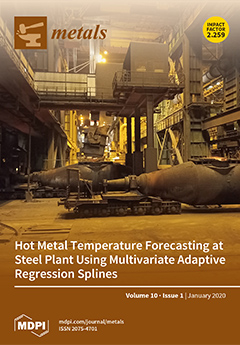Nickel laterite ore is divided into three layers and the garnierite examined in this study belongs to the third layer. Garnierite is characterized by high magnesium and silicon contents. The main contents of garnierite are silicates, and nickel, iron, and magnesium exist in
[...] Read more.
Nickel laterite ore is divided into three layers and the garnierite examined in this study belongs to the third layer. Garnierite is characterized by high magnesium and silicon contents. The main contents of garnierite are silicates, and nickel, iron, and magnesium exist in silicates in the form of lattice exchange. Silicate minerals are difficult to destroy so are suitable for smelting using high-temperature pyrometallurgy. To solve the problem of the large amounts of slag produced and the inability to recycle the magnesium in the traditional pyrometallurgical process, we propose a vacuum carbothermal reduction and magnetic separation process to recover nickel, iron, and magnesium from garnierite, and the behavior of the additive CaF
2 in the reduction process was investigated. Experiments were conducted under pressures ranging from 10 to 50 Pa with different proportions of CaF
2 at different temperatures. The experimental data were obtained by various methods, such as thermogravimetry, differential scanning calorimetry, scanning electron microscopy, energy dispersive spectrometry, X-ray diffraction, and inductively coupled plasma atomic emission spectroscopy. The analysis results indicate that CaF
2 directly reacted with Mg
2SiO
4, MgSiO
3, Ni
2SiO
4, and Fe
2SiO
4, which were isolated from the bearing minerals, to produce low-melting-point compounds (FeF
2, MgF
2, NiF
2, etc.) at 1315 and 1400 K. This promoted the conversion of the raw materials from a solid–solid reaction to a liquid–liquid reaction, accelerating the mass transfer and the heat transfer of Fe–Ni particles, and formed Si–Ni–Fe alloy particles with diameters of approximately of 20 mm. The smelting materials appeared stratified, hindering the reduction of magnesium. The results of the experiments indicate that at 1723 K, the molar ratio of ore/C was 1:1.2, the addition of CaF
2 was 3%, the recovery of Fe and Ni reached 82.97% and 98.21% in the vacuum carbothermal reduction–magnetic separation process, respectively, and the enrichment ratios of Fe and Ni were maximized, reaching 3.18 and 9.35, respectively.
Full article





